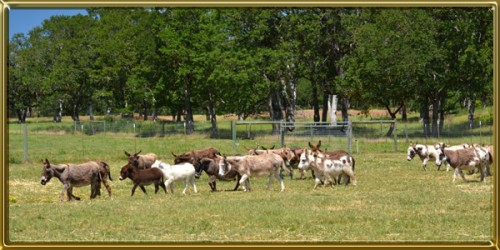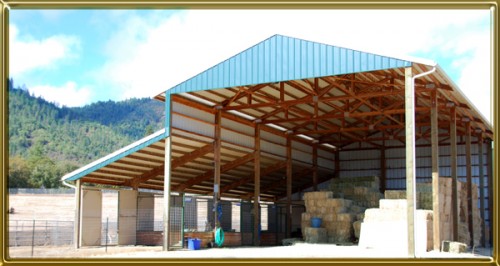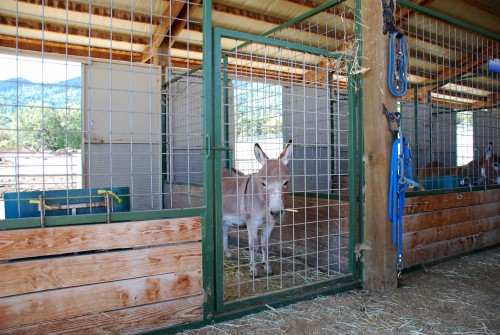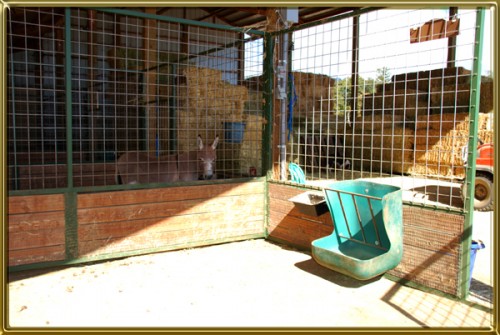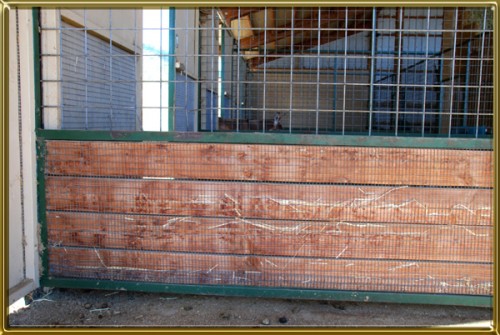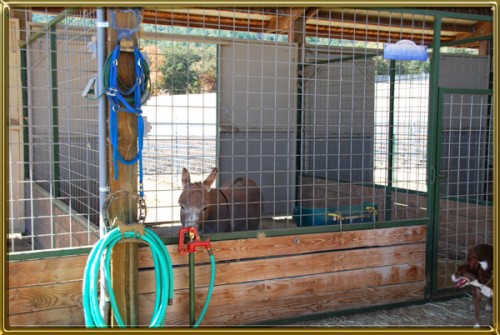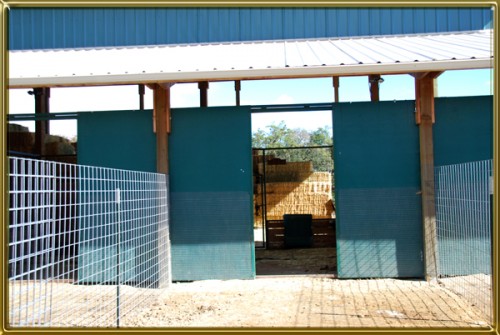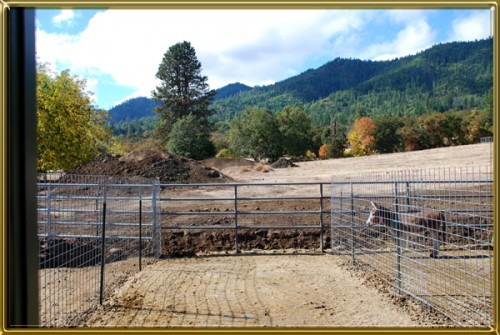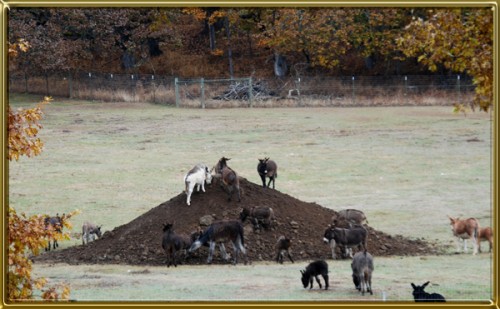written by Cindy Benson
2012
When our donkey herd went from 25 donkeys to 100 in 2006 it was clear that we needed to build some fences and a barn or two. Our 360 acre ranch had no fencing to speak of when we bought it in 2005 and the only barn was one large, historic, grand, cedar barn. We began fencing and cross fencing the property for our horses, mules, mini cows, and my donkey herd. Most of our fences are 5′ non-climb woven wire and the pastures have large run in shelters in them. We built the fences to accommodate the large equines, knowing that the smaller equines would be safe in them as well. Our use of the ranch is always in flux with pasture management and the changing needs and number of our stock. Building the fences this way has given us great flexibility. All of our fences either have an electric fence wire on the top, or one chest high to whoever is using the pen, or both. This insures that our fences look great for years and years because the animals can’t scratch on them and stretch the wire out of shape, and they don’t fight through them. Another benefit is that this protects our wood posts from being chewed on. Good fencing is a sizeable investment and is worth protecting, in our opinion.
I wanted one specialized barn for the donkeys and set about designing my dream barn – and here it is!
I wanted the barn to be largely out of sight of the house, have great drainage, and be one my hay provider would love. So my husband and I met with the site designer, the barn builders, and my hay man to decide what would work for us all. This turned out to be such a wise decision. The barn behaves beautifully on the property with the solid back wall facing the weather and the rain draining off and away as promised. My beloved hay man told us what he needed in terms of easy access with his hay squeeze and what would work best regarding the size of the blocks of hay. The interior space of the hay barn portion is 60′ x 30′. It will hold 2 1/2 truck and trailer loads of hay. It easily accommodates three blocks of hay side by side and gives me an 8′ alley along the front of the stalls. The barn cost us $30,000 to build, including the $5000 it cost to build the overhang for the stalls.
I have five 12′ x 16′ stalls along the back side. I designed the stalls myself and had a local welder build the framework for me. This cost was extra. The open design of this barn works well for us in our moderate weather. Our wind comes primarily against the back side of the barn so the stalls are protected, as is most of the hay in the winter months. Since I store a large volume of hay in the winter the stalls stay pretty warm because this closes up the barn quite a bit. These photos were taken in the summer when I don’t have as much hay and the air flow through the barn is wonderful. The stalls stay cool. I use this barn primarily for a few of my jacks (I seem to collect them as other women do shoes!) and they really like to keep an eye on all the activity at the ranch; they love these open stalls. However, this barn would work well for any of the donkeys.
The aspect of this barn that is designed specifically for the donkeys is the way the stalls are built. Donkeys absolutely hate to be alone – and there are times this is necessary. Many adult jacks will not tolerate living harmoniously with others and are best kept alone but are content if they can keep an eye on the rest of the herd. I prefer to keep my jennets alone in their last days before foaling, and a sick donkey sometimes needs to be kept alone. A donkey housed alone in a typical horse stall is basically jailed as he can’t see out of it. That donkey will stress markedly and I think that is an unfair position to put a donkey in. As you can see in the first photo it is possible to easily see every donkey in the stalls from far away. This allows me to keep a good eye on things as I go about my regular day of chores. Also, the donkeys in the barn keep an eye on me and are entertained by all the activity.
I have used heavy wire panels (typically called cattle panels in our area) framed in steel for my stall walls. The reason the interior walls are so tall is that this is the height the panels come in and it would have cost me more to have them shortened than it did to leave them alone. The size of the openings in the panels is critical. Mine are 4″ x 4″ squares. The openings are large enough that if a donkey gets a leg through he can get it back without risk of being hung up in the fence, and the openings are too small for him to get his head or muzzle through. Some kinds of panels have 6″x12″ openings – these are dangerous because of the risk of a donkey getting his head trough it and getting hung up or enough of his muzzle through it to get a good bite of his neighbor. Some panels are graduated in size with the bottom portion having 2″ x 4″ openings. I have seen donkeys get a hoof though them and become trapped. So, I feel the 4″ x 4″ opening panels are the safest. The lower 2′ of the stalls are solid so that I can bed them if I want to and have the shavings stay where I put them. The framework allows me to add new boards as needed over time without taking apart the barn. There is an notched opening at the top of the framework for the boards.
Inside each stall I have a plastic hay feeder, a trough to hold loose minerals, and a big water bucket. My hay feeders have rounded and somewhat flexible edges so that my donkeys would have to work pretty hard to get hurt on them. The feeders are mounted low on the walls to allow the donkeys to eat at a natural height. In our area we need to supplement selenium so that is what the small trough is used for. I always feed loose minerals separate from feed. I use muck buckets for water, rather than automatic waterers, because sometimes our water freezes in the winter and I may need to have the volume of water in the buckets for several days, or if a pipe breaks on the ranch this may become important. I dump the water buckets and scrub them every 2-3 days to be sure the donkeys always have fresh water.
The photo below shows how I protect the inside wood surfaces from my sometimes voracious donkeys. All interior wood surfaces have been lined with heavy gauge 1/2″ x 1/2″ hardware cloth stapled thoroughly to the wood. The wire is heavy enough that it holds it’s shape and stays looking nice, and so far the donkeys have not been able to get purchase on it. The photo below shows a close up of this treatment six years after I installed the wire. This pen has had a jack in it consistently and I think it still looks pretty nice. The solid wood portions of the stall are lined 4′ high, which is high enough that jacks have not been able to chew above it.
The photo below shows a close up of the front of the stall. I have designed the stall doors to open both ways which I have come to appreciate. When I go inside briefly I leave the latch closed against the inside of the stall so that the door looks closed to the jack inside, and if he does challenge it the door will push against the bolt and stay closed. Sometimes I do this when I am entering the stall too if I think the jack may try to bounce the door against me, as in the case of having a tasty jennet in the barn for him to admire. Sometimes they forget to be patient.
If you look closely at the stall on the right, and in the earlier view of the stall front, you will see an eye bolt set into the lower front of the stall. I use these to tease jennets with. I run a lead rope through the eye bolt and step back to the end of the lead rope while drawing the jennet up close to the jack. This allows me to get a good read on the jennet while staying safely out of the way and without providing distraction. Incidentally, I also use these stalls to breed jennets in. I hand cover almost all of my jennets and find that bringing them to the jack, rather than the other way around, works best for me. When I tease a jennet I first put a halter on the jack while he is calm. I lock all the other jacks outside their stalls and out of view. Then I bring the jennet up to see if breeding at that time is appropriate. If it is I tie the jack I am going to use outside in his run while I bring her into the stall. Then I tie the jennet to the center support inside the stall. I bring the jack inside near her in a controlled fashion. I use a 20′ lead rope on the jack and run it behind the center support behind her up high so that I can leverage against it when supervising the jack. This just makes it a little less physically demanding for me.
This next photo shows the outside of the end stall and run. The right side of this stall is open and the run begins off the front edge of the stall. This creates a large, in this case 60’x100′, area to live and play in. I also take a jack with me sometimes when I feed and let him run beside my Kubota RTV, and they get to play in larger areas from time to time. I make sure they all get lots of exercise and mental stimulation. This is extra important for the jacks.
The back of the runs are still under construction. We have recently added a large, sloped drainage ditch off the back of the runs. We will now fence across it and at least double the length of the runs. The back pipe panel fence you see here is temporary. It is lined with a mesh panel on the inside and has a chest high electric fence along the back side. This field is full of jennets that like to talk to the jacks so these extra measures keep everybody safe while we are in transition. Incidentally, check out the large dirt piles in the background. Most of this is dirt that was displaced when we did the site work for the barn. We were going to truck it out of there until the donkeys showed us how much fun they have playing on them. So there they stay, and in fact we have added a good sized dirt pile in every other large field we have just for the donkeys to enjoy. And, we have imported very large stumps into every field for the donkeys to scratch on and climb on.
All the donkeys, young and old, take full advantage of their new “toys” and are a hoot to watch!
Well I hope I have given you some ideas on barn and fencing options. Obviously there is no one right way to create housing for your animals and many factors need to be considered. I love my barn and for our size of operation, weather considerations, cost, etc., it works for us. I would be happy to answer any questions you may have and I’d love to show it to you in person so please feel free to come for a visit
